New York-based photographer, Ina Jang, cuts, pastes, and rearranges her photographs. She begins her editing process by selecting images from a collection of pictures, and then edits the elements within each photograph to find the perfect harmony between location, product, and model.
Jang’s work is as much about presenting visual information as they are about the absence and elimination of tangible and recognizable knowledge. They are simultaneously playful and conceptual, tackling ideas of what the photographic and the 2D image can be both in their ability to convey information and as a physical object.
We spoke with Jang about her editing and image making process, and her commission for Hyères Festival in 2012.
WHITEWALL: Can you talk the commission you did for the Hyères Festival? Was there a certain level of responsibility or intention when creating these images?
INA JANG: The main responsibility for the Hyères Festival was to show ten short listed designers’ garments as well as to create visuals that represent my personal approach in making images. The huge inspiration was from my personal body of work “btwn” in which I made minimal portraits of objects by masking part of them. The creative team of Hyères and I both thought it’d be great to focus on the shapes and colors, presenting ten distinctive outfits in a collective way.
I selected colors and made shapes that do not interfere with showing unique details of each garment before the shoot. It was challenging to deal with some of larger shapes on the set – I had to cut them into different forms on the spot to reveal more of the clothes. Scissors and tapes had to be within my reach at all times.
WW: When you approach an image do you have an idea of what will be included in the final image or is it more about taking all the information at the end and seeing what works and what is necessary?
IJ: Most of my photographs start from rough sketches I draw in my journal. My ideas are always clear from the beginning, so I already know what will be included in the final image.
WW: I would say your work is more about editing rather than collaging. Can you talk a little about how you got started working in this way?
IJ: When I first came to study photography in New York, I was struggling with finding a perfect location to realize the ideas that I had drew in my Moleskins. The city was too busy for my love of minimalism, so I decided to use empty classrooms and my studio apartment as a solution to “edit out” the city from my photographs – it sounds silly now, but back then using a photo studio was not even an option for me, as I was never interested in (or afraid of) using studio lights. It was a huge departure from my previous approach to photography where I was always outside, and trying to drop my ideas into a location. I thought of the empty (often white) spaces as white canvases where I could draw-in people or objects.
Although the initial intention was to eliminate unnecessary elements in the photographs, it also is very much about “adding” when it comes to my process of making images. If anything, most of the collage is done in real life. For example, the series I did for Hyères Festival was done in a way that I had the floating shapes in front of the models. This is similar to the story I did for Jalouse magazine in April. I had a two-day shoot to create a huge print, which would be the first layer of the final image. Then I made holes on the first layer, which were printed large enough to hide the model behind and they were pasted on foam core. The first layer was placed in front of a model and she had to put her hands or legs with accessories into those holes.
WW: When approaching fashion images or commercial work, how do you confront the mandate to include certain things in the image? Is there a crucial difference in addressing commercial work, commissions, and your personal work?
IJ: My approach, in terms of coming up with ideas and visuals does not change, and I try not to make a clear borderline between those two. The huge difference is in the logistic part – there are more people involved in a project when I work on fashion images. You are working with people who have different opinions. This naturally makes a difference, as I tend to be by myself in an enclosed space when I work on a personal project.
Ina Jang received her MPS in Fashion Photography from the School of Visual Arts and was shortlisted in the 2011 Photography Competition of the Hyeres Festival. But her work that engages with fashion parallels her personal work further pushing our expectations of contemporary fashion imagery.








